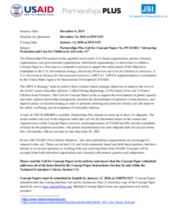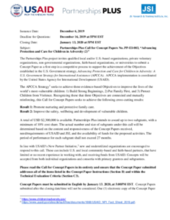Demographic Data
|
Sources: World Bank, UNICEF, UNDP HDR 2015, DHS 2014/2015 |
Displaying 4841 - 4850 of 14348
This article explores the impact of preadoption history upon physical, mental, emotional, cognitive, and developmental well‐being of children and the need for adoptive parents, medical and mental health professionals, and schools to understand these impacts.
This article from NPR describes the growing global movement to move away from orphanage care for children, and discourage orphanage visits and volunteering which often drives the separation of children from their families.
The Partnerships Plus project invites qualified local and/or U.S.-based organizations, private voluntary organizations, non-governmental organizations, faith-based organizations, or universities to submit a Concept Paper as a first step in a competitive process to support the achievement of the Objectives established in the U.S. Government strategy, Advancing Protection and Care for Children in Adversity: A U.S. Government Strategy for International Assistance (APCCA).
The Partnerships Plus project invites qualified local and/or U.S.-based organizations, private voluntary organizations, non-governmental organizations, faith-based organizations, or universities to submit a Concept Paper as a first step in a competitive process to support the achievement of the Objectives established in the U.S. Government strategy, Advancing Protection and Care for Children in Adversity: A U.S. Government Strategy for International Assistance (APCCA).
This study explores the development of abused children in different areas. Likewise, it looks into differences of the level of development in relation to age, gender and type of abuse.
This qualitative study examines the challenges foster caregivers face within their families and seeks to understand their formal and informal support systems so that future trainings may be created to provide for the specific and realistic needs of foster caregivers.
This study examines the link between perceived staff social support and emotional and behavioral adjustment difficulties of adolescents in educational residential care settings (RCSs) designed for youth from underprivileged backgrounds in Israel.
This study examined the long-term effects of the Head Start early childhood program on foster children's developmental outcomes from ages 3–4 to 8–9.
New federal legislation in Canada now allows First Nations to take control of their own child welfare, and the Saskatchewan First Nations organization is now asking the federal government to transfer funds to First Nations agencies, allowing them to set up and run high quality services in their own communities, according to this article from CBC News.
This study examined early trajectories for academic and social skills among four groups of rural, preschool-attending, children in the Guangdong province of China: Village children who remained in a rural village and lived with both parents, Migrant children who migrated with their work-seeking parents to live in an urban area, Partially-left-behind children who lived with one parent in a rural village while the other parent migrated to the city for work, and Completely-left-behind children who stayed in a rural village with relatives while both parents migrated to the city for work.


